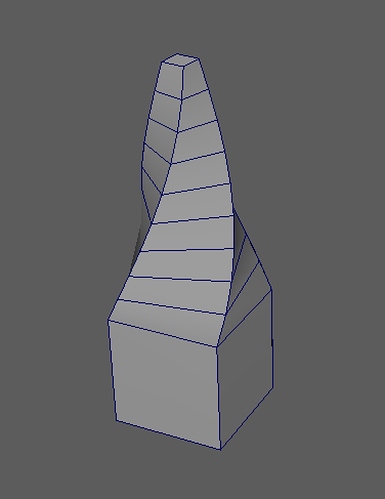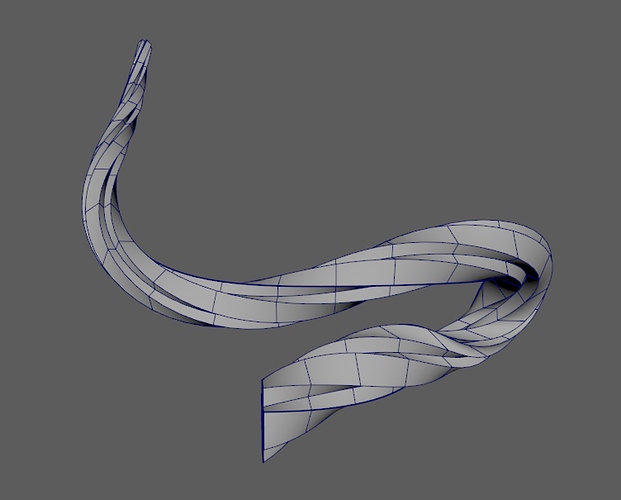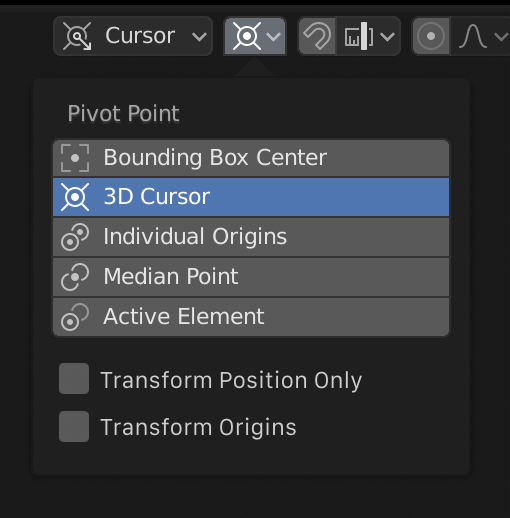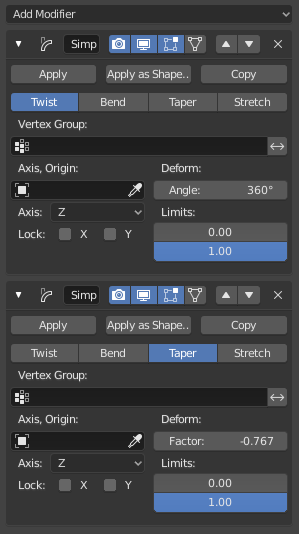Once you understand how the 3d cursor works everything will change in your mind,it’s lighyears ahead from maya the problem is that you working with the maya style and this is the biggest mistake  try to understand how blender works and trust me you gonna love it
try to understand how blender works and trust me you gonna love it
But that is not a pivot that you are moving. That is just origin of object.
Pivot of transformations may be 3D Cursor.
In that case, moving pivot = moving 3D Cursor.
It can be active element.
In that case, snapping pivot to an element of mesh = selecting the element.
Generally, when you animate an object : it is rigged, following a bone.
So, moving origin of objects is annoying in Blender. But in many cases, we don’t care about origin at all.
Object origins are possibly one of the more obscure parts of blender, but the typical approach it takes is to give the user a bunch of low-level tools, they learn to work fast with the basics, and with that, they can do anything.
Blender doesn’t give you subdivisions on the cube, it gives you the tools to subdivide things quickly, it doesn’t give you a tool to snap the origin, it gives you a tool to snap anything.
It includes other more specific tools ontop of that, but at the base you’re best off if you learn to work fast with these basic ones, rather than pining over any specific tool - because you’ll be able to then do anything quickly, and adapt quickly aswell.
This aswell, most of the time I personally don’t even track where the object origins are, or I continually reset them to the center of the bounding boxes, because they’re not particularly important. Any time they become pertinent, there’s usually a couple objects that I need a specific pivot point for in some sort of rigging - at which point an empty works just as well if not better. Either that or I’m running something along a curve, but that comes up infrequently enough I just use the 3d cursor, but then because I use the 3d cursor for a bunch of other things (again, an emphasis on basic tools with lots of applications), that’s super quick for me.
Once you understand how the 3d cursor works everything will change in your mind
My wife told me the same thing about tofu. I still don’t like it. ![]() That being said, I’d love to see how efficient that is compare to Maya. Any examples?
That being said, I’d love to see how efficient that is compare to Maya. Any examples?
Now, you guys talk about fast workflow. I made this little clip to show you how pivots are handled in Maya.
Just by pressing D (and other keys depending on the snap I want) I can move the pivot, snap it on the grid, edges or vertices. I can orient the pivot according to a face, edge or vertices normal. I can align the pivot on an edge. If I’m in vertices mode (or edge or face), I can do the same thing but that will only be a temporary pivot only for the selected vertices and it will not affect the object’s pivot. I didn’t need to move a 3D cursor somewhere then call a function. It’s all done in one shot. I move pivots hundred times per day. The difference here is that in Maya, I get into pivot mode. Everything I do from then is only for the pivot. As soon as I release the D key, I go back to where I was. In Blender, I have to do one step, then call a function.
Previously I wrote that CTRL-R worked for me as a workflow. Then I asked myself, how would I do this?
In Maya, you do this as you extrude as you have divisions, taper, rotation and more as you do it. I guess in Blender I would have to select the top poly, use some kind of proportional modification, scale and rotate. But that wouldn’t work for something like this:
But maybe there’s another way to do this in Blender.
I still have a lot to learn and to adapt to.
Users have requested a way to interactively move around the object origin (pivot point) for many many years.
I see no particular reason why we shouldn’t simply add this. We already have interactive ways to move the ‘Texture Space’ (which is much less generally useful I think), and we also have ways to move objects using the ‘Only Origins’ option.
2.8 is in feature freeze, so it probably won’t be added before 2.80, but I think it’s something we should do at some point.
The main question is how to add this into Blender’s UI and tools. I see three main options:
- Integrate it as a tool setting for the Move, Rotate and Scale tools
- Add it to the Pivot Point popover as an option, just like Only Origins (makes it compatible with G, R, S modal transform too)
- Have an entirely separate tool or command to initiate it, similar to Object > Transform > Move Texture Space
I’m probably leaning towards #2. It’s relatively discoverable, unlike #3, and will work with all our current ways to transform.
Could look like this:
Transform Positions Only is the old Origins Only, but with a new name. The old name would be confusing next to the new option to transform the origin.
@BlenderBob Don’t waste your time, this is being requested since forever. Hardcore blender users will never understand.
Quality of life is not a thing in blender’s world. All that matters here is to achieve the goal, no matter how convoluted and counter-intuitive it is. If something can be done, it will automatically be promoted as the best way of doing it.
So, basically all you have to do is forget about intuitive workflows and you’ll be fine. 
The object origin and the current pivot point aren’t the same thing.
Pivot is made up of orintation and a point, defined here:
The 3d cursor implements a lot of the things you described, including snapping to mesh features (edges, verticies etc). So you can use the 3d cursor for that, if you select the 3d cursor as the point and orientation.
It also respects the current snapping settings defined here:
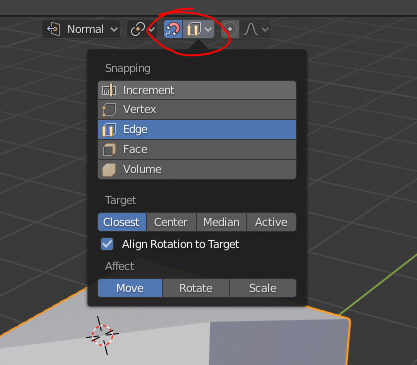
Though a pie for quickly swapping between vert/face/edge snapping modes, and enabling/disabling aligning to rotation might be a good idea.
Yaiks!..
Well, what Blender calls ‘Origin’ is often called ‘Pivot Point’ in other software.
‘Origin’ often means World 0,0,0 location.
True, but if in other software people are moving it about all the time, they’re hardly the same thing.
Maya and blender have different approach to pivot points. (center of transformations). In blender you have this menu 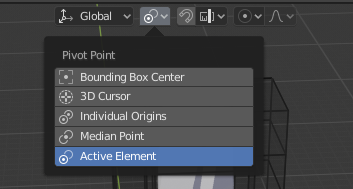 We don’t move “pivot point” (center of object) to do transformations around it. You can use “3d cursor” or “avtice element” for that. But snapping 3d cursor and pivot point (orange dot) were requested a lot of times, it would be handy too.
We don’t move “pivot point” (center of object) to do transformations around it. You can use “3d cursor” or “avtice element” for that. But snapping 3d cursor and pivot point (orange dot) were requested a lot of times, it would be handy too.
As for taper and twist. In blender i would use modifiers for that. Something like this.
2 “simple deform” modifers on top of each other. Twist and taper selected.
I don’t think you read the post directly above yours? I think yes, we should add it. Maybe when 2.80 is out and things are more stable.
It’s probably not a massive feature to add, but it’s something users have wanted for years and years, and something that virtually all competing apps have, so I see no particular reason why we should not add it.
The ability to snap the origin to other things, including the 3D Cursor, does not have to be the only way to move it, just like it’s not the only way you can move regular objects normally either.
If it got complex, (like the second example) I’d use a two curves, one for bevel, one for the path. Easier to edit later, too.
I guess the big question is: What’s Blender’s goal? Is it to take over the CG world, be just a hobby or lean towards small studios who can’t afford Maya, 3DMAX, Houdini and all.
I’m amazed by the amount of thins that are in Blender. It looks crazy powerful, fully featured, especially considering that it doesn’t have the unlimited ressources of Autodesk. Awesome job guys! I have yet tried to import scenes with thousands of objects and millions of polys to see how or if it can handle it.
Obviously, it’s not really for prime time (no offense to anyone). If that was the case, there would be many more studios using it. I know about this company in Canada that made a feature film (forgot the name) in Blender. I saw it on Netflix and I was impressed. But if the goal is to reach Hollywood, meaning big shops, Blender may have to abandon some of their precious out-of-the-ordinary workflow and make it more intuitive. Selecting with LMB is a good way to start. I think Blender has a lot of potential and could become a game changer. I’m still going to explore it and try to get in the Blender vibe. 
I was talking more about the general community here.
For what I could see, most of the time when people request/suggest a feature or improvements here, it automatically gets shutdown by the users, specially if it’s something that exists in other softwares. No matter what, people here will always tell you the blender’s way of doing something is the best and superior, when clearly it’s not.
It’s incredible.
addendum
Wow i didn’t even know that we could snap 3d cursor
On the about page you’ll find this link:
Regarding being easier to use for people from other software, this is what the industry standard keymap is for, primarily.
As for radically changing the workflows just to become a clone of maya or max or whatever other software so people can be happy with discount -insert software-, that would abandon the things that make blender powerful.
It’s not un-intuitive, it’s just not the same as some other software, and this is often what makes it powerful. A lot of people have a hard time understanding the difference, label the software as radical and elitist, and so never see that power themselves, then instead try to get it to mirror their favourite other software.
To nail that point home, here’s an excerpt from Ton’s “Mission Statement”
EASY TO LEARN vs EASY TO USE
Ideally you make tools to be simple to understand, tools that are self-explaining, that work fast and pleasant also when you”ve mastered them well.
In practice this isn”t always true – and certainly not for 3D technology and tools. If you choose to develop 3D tools to be easy to learn, you will make decisions to sacrifice speed and ease of use for frequent users. You will have to narrow down to a UI that”s optimal for generic (beginner) use cases more than for users who want to handle complexity and who have time for quality.For tools you use every day, you can simply state “Learn once, use the rest of your live”. So – focus for Blender tools is on making it usable first. Keep things consistent and fit with overall design. Tools then become logical and feel intuitive even.
Anyone who has adopted the modal tools, understands exactly what he’s on about here.
I’m glad you’ll try and explore it.
@ThinkingPolygons, have more excerpts.
WE MAKE BLENDER FOR BLENDER USERS
This is not meant exclusive or to keep people out – everyone can use Blender freely and become a user. I usually state this provocatively to explain that I”m not much interested in “getting more users”. That”s not a sane target to work for. Nor am I much interested in supporting Maya users, Sketch-up users, or the forum trolls who don”t use Blender anyway. Why would we in the first place? Why work for people who are not much interested in your work, if you already have like hundreds of thousands of users who are?
…DON”T LOOK UP TO AVERAGE
In daily computer use you will open many programs that each do specific tasks. You can do some painting, text editing, page design, image editing, all without being interested (or even motivated) to spend a lot of time in becoming skilled in these areas.
That”s when standards kick in, the averages, conventions, common defaults and largest denominators. That”s all fine and useful for getting quick results. But it”s not something that makes it by definition “good” to do, or something to look up to – you would forever put yourself in a position of a newbie then.
…
…I want to lift up the average. It”s not following conventions, it”s following a vision.
There’s nothing superior or philosophically clever about making sure it’s difficult to move the origin. It’s just a missing feature, that’s all.
No need to make it a bigger deal than that.
@BlenderBob
hehehe you see that happens if you tease the monkeys by telling them that you don’t have the tools to be able to scratch your back…
you risk triggering a revolution here.
